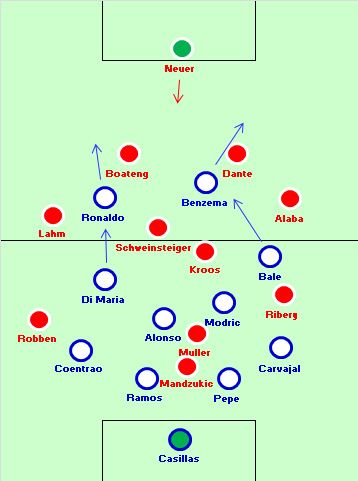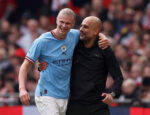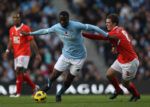Toni Kroos is good at many things, but defending is not one of them. He can tackle, but he is not a ball winner. He reads the game well, but is no Sergio Busquets or Claude Makelele. He has good stamina, but he cannot harass opponents. Yet a number of the world’s top coaches, Guardiola, Ancelotti, Benitez and Loew, continue to play him as a defensive midfielder. Now, there might be some things these coaches know, or see in training that I am not privy to, but I believe Kroos’ career shows a pattern of underwhelming performances in deep positions, and strong performances in attacking roles.
Toni Kroos: Early Career
My first time seeing Toni Kroos play was at the 2007 u-17 FIFA World Cup. Playing as a #10, he captained the German side to a third place finish, picking up the Golden Ball for the best player of the tournament, and the Bronze Boot after finishing as the third highest goal scorer with 5 goals. In the semi-final against Nigeria, Kroos scored Germany’s only goal in a 3-1 defeat. Picking up the ball 25 yards from goal, he faked to shoot with his right, before shifting it onto his left foot, eliminating two defenders in the process, and curling a precise left-footed shot into the bottom corner. It was a goal that highlighted Kroos’ strengths as a player; remarkable composure on the ball, two-footed-ness and unerring accuracy.
https://www.youtube.com/watch?v=uR8lr_wDROg
After moving to Bayern’s youth set-up in 2006, and making his debut for Bayern as a 17 year old, Kroos began to see regular minutes when Bayern sent him on an 18-month loan to Bayer Leverkusen in January 2009. After an initial settling-in period, Kroos and Leverkusen really took off in the 2009-2010 season, finishing the first half of the Bundesliga season top of the table and going 24 games unbeaten before a late season collapse derailed their title ambitions, and they eventually finished fourth. Regardless, Kroos did his prospects no harm, finishing the season with 9 goals and 12 assists in 33 appearances from an offensive midfield position.
Return to Bayern Munich
Kroos was part of Germany’s 2010 World Cup squad, and returned to Bayern Munich in the summer. Under new coach Juup Heycknes in the 2011/2012 season, Kroos began to assert himself in the first-team as the #10 in Bayern’s 4-2-3-1 formation behind frontman Mario Gomez, keeping Thomas Muller out of the side.
One of Kroos’ best performances that season came in Bayern’s 2-1 defeat to Real Madrid in the second-leg of the Champions League semi-final at the Bernabeu. Needing to overturn a 2-1 deficit, Real Madrid flew out of the blocks, taking an early 2-0 lead, courtesy of two goals from Cristiano Ronaldo. Kroos, playing in the #10 position, put in a wonderful performance, with his composure on the ball helping Bayern wrestle control of the game from Madrid and pull a goal back through a Robben penalty. Kroos outperformed the opposition #10 that night, the German midfielder Mesut Ozil, and despite missing his penalty in the shootout, he was one of Bayern’s best players. This is a video of his performance that night
With Schweinsteiger’s regular defensive midfielder partner, Luis Gustavo, suspended for the final against Chelsea, Kroos partnered Schweinsteiger, with Thomas Muller filling in at 10. Despite creating Muller’s goal with a cross, Kroos had a poor game, unable to influence proceedings like he did against Madrid. Bayern were beaten on penalties, and the first signs of Kroos struggling in a defensive midfield position were evident.
In the semi-final of Euro 2012 against Italy, Low decided, bizarrely, to deploy Kroos to man-mark Andrea Pirlo. Kroos couldn’t get close to him, with Pirlo constantly finding space and playing his best game of the tournament, as Italy beat Germany 2-1. Once again, in a defensive capacity Kroos was found wanting.
European Champion and Pep Guardiola
After adding Swiss winger Xherdan Shaqiri to their ranks, Bayern had five players to fill three spots behind new signing Mario Mandzukic. Robben and Shaqiri were left out, with Ribery and Muller preferred on the flanks, and Kroos as the #10. Kroos had a good start to the season as Bayern set a blistering pace in the Bundesliga, scoring the opening goal in the first league meeting between Bayern and the reigning champions Dortmund at the Allianz Arena (the match ended 1-1 with Mario Gotze scoring the equalizer for Dortmund). Kroos scored the opening goal for Bayern in their first-leg 3-1 victory over Arsenal in the CL RO16 tie at the Emirates, with a fine half volley, but an injury against Juventus in the first leg of the QF ended his season, with Robben taking his place and Muller moving behind the striker. Bayern would go on to win the treble that season.
With the arrival of Guardiola in the summer of 2013, Bayern moved away from the 4-2-3-1 to a 4-1-4-1 formation. Philip Lahm moved to defensive midfield, with two of Kroos, Thiago or Schweinsteiger ahead of him.
Kroos’ best performance came against Arsenal, once again in the CL RO16 at the Emirates. He completed 147 out of 152 attempted passes , and scored the opening goal . It was also his clever chipped pass that put Robben through on goal before Szczesny brought him down and was sent off. Kroos played alongside Thiago that night, with Javi Martinez playing as the defensive midfielder.
In the second leg of the semi-final against Real Madrid at the Allianz Arena, needing to overcome a 1-0 first leg deficit, Guardiola played Kroos alongside Schweinsteiger in defensive midfield, playing Muller as the #10 for a more attacking setup .

The results were disastrous; Bayern lost 4-0 and once again, Kroos was exposed.
Brazil 2014.
Germany’s first four games in the 2014 World Cup featured Philip Lahm as the pivot in a 4-3-3 formation, with Kroos and either Sami Khedira or Schweinsteiger ahead of him.
They hadn’t looked entirely convincing, with shaky performances against Ghana and Algeria. For the QF matchup against France, Loew changed to a 4-2-3-1, with Lahm moving to right back, and Kroos moving to the #10 position.
Germany put in a very accomplished display, with Kroos providing the assist for Hummels’ headed winner, and dominating the midfield, ensuring that France never got back into the game. In the semi against Brazil, Kroos, playing in the #10 position, set up the first goal for Thomas Muller, and scored twice. But, in the final, Kroos was underwhelming. After starting again as the #10, he was forced to move into defensive midfield alongside Schweinsteiger, after Christoph Kramer, Khedira’s replacement, was stretchered off with a head injury after 24 minutes. Kramer was replaced by Andre Schurrle, who moved to the left-wing position, forcing Ozil to take up Kroos’ former position. Kroos struggled for most of the game, almost costing Germany with an underhit back-pass which was intercepted by Higuain, but the forward put it wide
https://m.youtube.com/watch?v=hHbQIveDjyU
Kroos was one of ten players, including four Germans, shortlisted for the Golden Ball award, and was named in the team of the tournament, finishing with 2 goals and a joint high 4 assists (along with Juan Cuadrado). Once again his best performances came as an attacking midfielder, with his worst in defensive midfield.
Real Madrid
Kroos moved to Real Madrid in the summer of 2014. Under Carlo Ancelotti, Kroos played as the holding midfielder in a 4-3-3, alongside Luka Modric and James Rodriguez or Isco. He was heavily criticised in his first season, particularly for his defensive performances. He played the most games of any member of the squad (55), as Madrid finished the season trophyless.
Under new coach Rafa Benitez, Kroos again continued to play the majority of his matches as a defensive midfielder and was continually exposed, most notably in a 4-0 defeat to Barcelona in the Bernabeu. After Benitez was replaced by Zidane, the Brazilian defensive midfielder Casemiro was inserted into the first team as the defensive midfielder in the 4-3-3, and Kroos was moved into a central midfield role to be partnered by Luka Modric. Kroos’ performances improved drastically and he was Madrid’s best player in the CL final until he was replaced by Isco, at which point Madrid lost control of the midfield, and allowed Atletico Madrid back into the game.
This post first appeared on r/soccer









Recent Comments